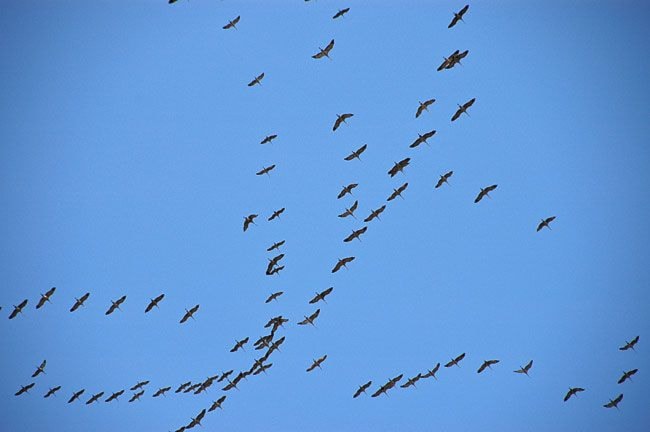George Happ didn’t mean to swear while describing his upcoming talk at Faro’s 10th annual Crane and Sheep Viewing Festival this weekend. But on Monday afternoon, it was snowing - again - at his home outside Fairbanks, Alaska.
And that’s a problem. It means he may not be seeing Millie and Roy again for a little bit. He’s worried. His annual guests are already late. Usually, they arrive between April 24 and 26 and don’t leave until early September.
Millie and Roy are sandhill cranes. Cranes typically mate for life, said Happ. And while he may be a retired biology professor, it’s his wife, Christy, who really got him interested in them. In 1995, the Happs retired to 40 acres of property outside of Fairbanks.
Christy began photographing different birds she saw. “She takes meticulous notes,” said Happ. And she noticed a couple returning each April looked the same. They estimate the birds have returned every year since the late ‘90s.
But with Millie and Roy nowhere in sight, Happ will be making his trip to Faro alone.
“(Christy) won’t leave here when Millie and Roy should be here,” said Happ. “She wouldn’t have come if they’d been here, because she’d want to watch them. She doesn’t want to come when they’re not here, because they might arrive, and she wants to see what happens, if they arrive late, and how they deal with it.”
Granted, the Happs don’t have DNA proof these cranes are the same, said Happ. But their facial marks and calls are the same, and they visit the same sites in the same order each year. “We’re pretty darn sure they’re the same birds,” said Happ. Christy’s been photographing them for about the past eight years, and keeping a journal of the visits for around 15 years.
Since then, the Happs have learned a lot about how cranes raise their young and dance. These are the lessons Happ will be presenting this weekend.
But it was never intentional. Their location has helped.
Many bird watchers live in suburbs, so they don’t get to see much natural behaviour. But the Happs live in a valley, on land not good for building houses. “We were very lucky in terms of being ignorant and finding the cranes, because we never would have been able to find them on a hilltop,” said Happ.
“Most people who watch cranes look at them when they’re migrating, so they’re just a big gang. They’re the New York City Times Square or Tokyo or someplace like that. They’re big gaggles of cranes jumping around and yelling at each other,” said Happ. But the Happs have been able to watch this pair closely, and that’s made all the difference.
“There’s a whole lot more going on than a big bird jumping up and down,” he said. “Dancing is a social cement for cranes.”
Different dance postures mean different things. In the summer, cranes dance gracefully, as if trying to warm up to each other. Millie has one step where she runs, jumps in the air, puts her wings out flat and glides down. Roy will race over and stand in front of where she lands. Then they bow and jump around. It’s “kind of like people-dancing,” said Happ.
But they’re not so united when they arrive in April. After driving away potential competition, Roy will pick up building materials, only to have Millie walk away. Eventually, they mate and she joins in on the construction. She lays eggs, one or two, which they take turns sitting on. The eggs hatch around the end of May or beginning of June.
Since 2004, the couple has been raising babies, called colts, on the property. So the Happs have watched them teach their offspring to dance. By July, colts dance along with their parents. Dancing is important. It helps them learn to fly, and also teaches socialization skills - a necessary part of migration. By early August, colts run alongside their parents, and try to fly on their own. Later, their parents take them on flying excursions. They fly away at the beginning of September, and the Happs don’t see Millie and Roy again until the next April.
Not all colts make it. Happ estimates Millie and Roy have only raised six colts that have migrated, he said. Colts die “for reasons we don’t understand.” Once, after a colt died, the parents and remaining colt spent the night dancing forcefully by its body.
But dancing is more than instinctual emotional expression. Cranes need to learn to dance. “These birds aren’t little machines,” said Happ. “There’s a lot of give-and-take and learning.”
The way cranes refine their dance moves is similar to how songbirds learn to sing. And studying how birds learn to sing can help researchers understand how human motor skills are refined. The way birds refine their dance moves is similar to how humans learn to throw a curveball, for example.
The National Institute of Health funds universities to study how different birds sing, said Happ. “Understanding how we do this motor learning for baseball is greatly aided by the very precise information you can get about how zebra finches learn to sing. It sounds like a large stretch, but it actually works,” he said
“There’s a lot more going on in their brains than many people have appreciated in the past.”
Visitors to Faro will get the chance to learn more this weekend. Happ is scheduled to speak Saturday night after the wild game barbecue. Or people can check out www.georgehapp.com.
Contact Meagan Gillmore at
mgillmore@yukon-news.com
